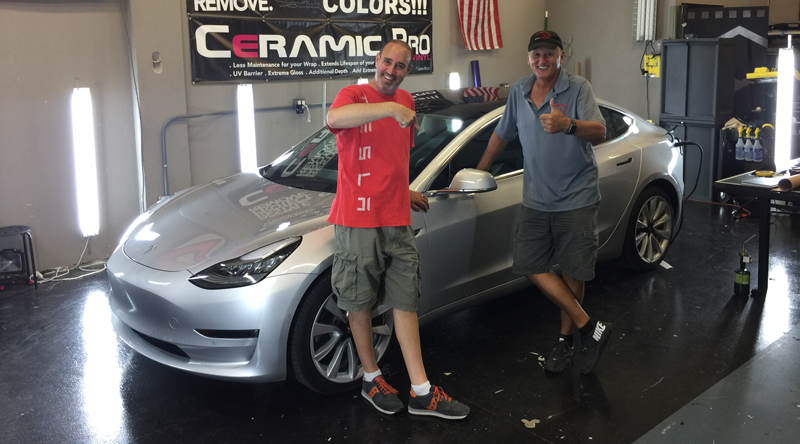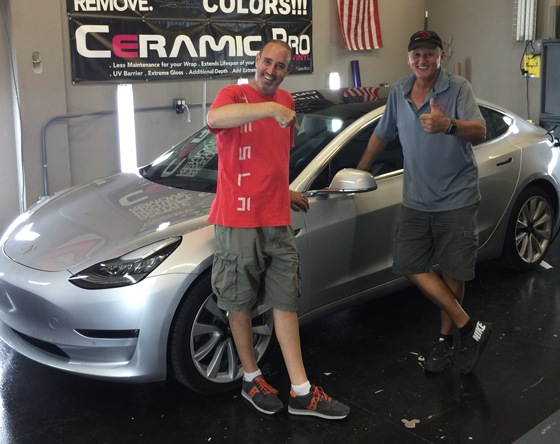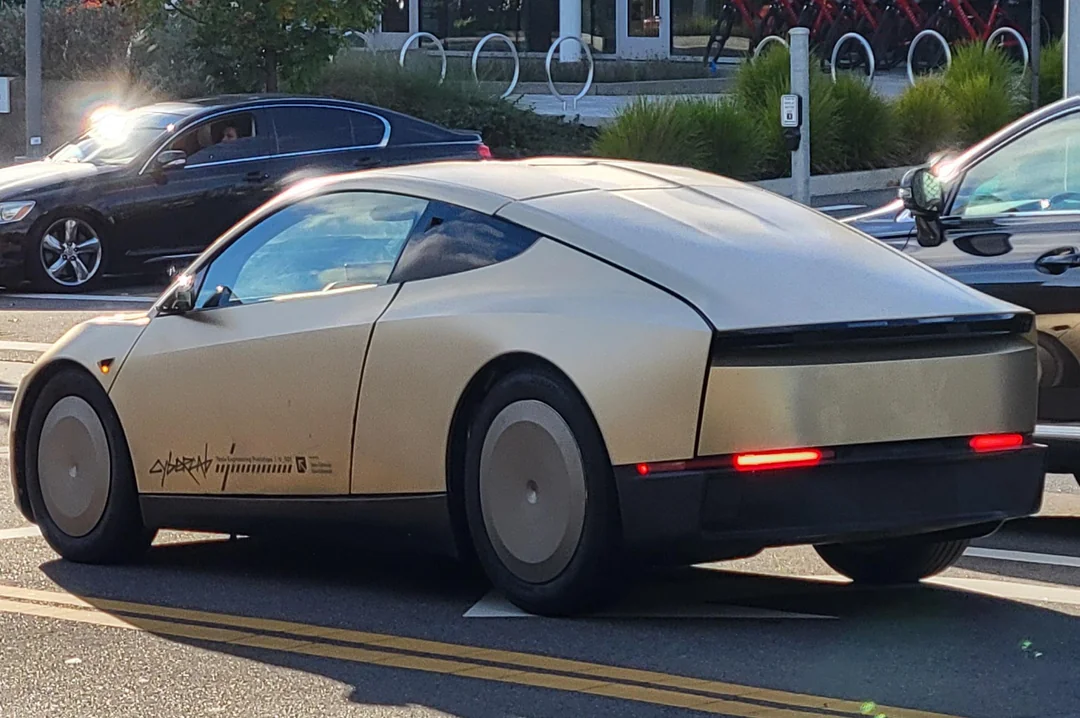

News
Tesla Showdown: We got a Model 3 and compared it to a Model S [Video]
We’ve seen a handful of Tesla Model 3 review videos floating around — including an excellent hour-long, deep-dive into the car’s features by our friends at Model 3 Owners Club. That said, we just got a chance to conduct an in-depth evaluation of Model 3 for ourselves. It’s a fascinating car and in our view, will come to dominate the mid-sized sedan segment over the next few years.
 |
Above: Considering the differences between the two Tesla sedans (Photo: EVANNEX)
In some ways, Model 3 demonstrates how Tesla has elevated its interior design capabilities and improved the integration of features, functionality, and storage as the company moves forward. In other ways, Model 3 reinforces the contention that Model S remains Tesla’s flagship sedan. We think it’s worth comparing and contrasting the two Tesla sedans to better understand the differences between the cars.
Above: Examining a few of the subtle, and not-so-subtle similarities and differences between Tesla’s Model 3 and Model S (Youtube: EVANNEX)
We spent two full days with the Model 3, reviewing the interior and exterior in granular detail. We examined the car through the lens of five years (since 2012!) of Model S ownership. Sure, some Tesla owners (like us) are wondering how these siblings stack up against one another. But there are many others pondering the possibility of owning their first Tesla. The big question is… if you’re considering the purchase of a Tesla Model 3 or Tesla Model S, which one should you buy?
Interior
Let’s compare and contrast some of the interior features of Model 3 and Model S with particular emphasis on driving and vehicle control displays, HVAC capabilities, interior volume and storage, the front driver’s compartment, and the little things that add functionality to the interior.
 |
Above: A look inside the Tesla Model 3 interior (Photo: EVANNEX)
Driving and vehicle control displays. The Model S boasts two digital displays instead of one in the Model 3. The Model 3’s horizontal, center display is also smaller (15-inch) vs. a vertical, center display which is larger (17-inch) in the Model S. Because Model S retains an information display immediately in front of the driver, it provides somewhat more comprehensive information content. As an aside, the 15-inch landscape display in Model 3 appears to be larger than it is and provides a full range of driving and vehicle information at a glance.
HVAC. Model 3’s HVAC approach demonstrates a significant step forward for Tesla. Both the Model S and Model 3 HVAC approaches are functional and capable, but the Model 3 has a definite advantage in terms of directional control and aesthetics. In addition, its novel design is impressive.
Interior volume and storage. Because Model 3 is a mid-size sedan, it can’t compete with Model S in interior volume—an important factor for many owners. Overall, interior volume in the Model S is far superior to Model 3. You get 30 cubic feet in Model S vs. 15 cubic feet in Model 3. As important in our view, the Model S hatchback design has significant advantages over the Model 3 conventional trunk opening. The hatchback opening provides very easy placement of large objects. It should be noted that the Model 3 trunk, when coupled with second row fold-down seats, does offer the ability to carry long objects with relative ease. The Model S also has a power lift gate instead of the Model 3’s manual trunk. In addition, Model S has a larger frunk than Model 3.
Seating. Model S has seating for 5 adults + 2 children (with rear facing “jump” seats). Model 3 only has seating for 5 adults. That said, Model 3’s seat quality, design, and overall spaciousness of the cabin were comparable to Model S.
Driver visibility. The interior design of Model 3 is striking in the sense that it eliminates the binnacle that normally sits directly in front of the driver, replacing it with a 15-inch landscape center display. With the binnacle removed, the Model 3 dash is lowered, allowing a more complete view of the road immediately in front of the vehicle. The large expanse of glass above the driver provides the feeling of an aircraft cockpit.
Center console. Sitting in the driver side cockpit of Model 3, it becomes obvious that Tesla has improved its interior design chops. The center console for Model 3 (available with the premium option package) is well-designed and functional. It offers easy mobile device charging, dual USB ports along with a 12V port, and elegant storage, complemented by storage compartments in the doors.
Lack of buttons. For Model 3, just about everything except window and door opening is controlled via the landscape display. This level of software control is impressive, but we felt that there might be times when it would be easier to use an analog alternative for, say, the control of the side mirrors or glove box.
The little things. There are little things you’ll find in a Model 3 that are absent from the Model S — coats hooks, built-in rear seat armrest, small storage compartments, back-of-seat kangaroo pockets, etc. To be a bit self-serving for a moment, most of these items can be had (in the aftermarket) for Model S from EVANNEX.
Exterior
Moving to the exterior, it’s apparent that Model 3 has the same vehicle DNA as Model S, but like all siblings, there are visual (as well as characteristic) differences.
 |
Above: Tesla’s sleek design of its new Model 3 (Photo: EVANNEX)
Looks. The most obvious (in-person) differences are the shorter hood for Model 3, the noticeably narrower width of the vehicle, and smaller wheels. Because it is shorter and narrower, Model 3 has a less striking stance than Model S. Overall, the larger size of the Model S is more visually impressive. We think it’s fair to state that many Model 3 owners will remedy some of these issues in the aftermarket, but in the case of Tesla’s sedan siblings, size matters.
Sensor suite. Autopilot (and ultimately, autonomous driving capability) will be available for both Model S and Model 3. It appears that functionality and capabilities in this domain will be identical.
Door handles. We did have a few small quibbles with Model 3. The push-rotate-grab door handles of Model 3 achieve the required aerodynamic advantages for an electric vehicle, but they pale in comparison to the auto-present and retract door-handles for Model S. We felt that Model 3 handles weren’t as ergonomic, particularly if you’re carrying something as you get into the vehicle.
Wheels. The 18-inch Model 3 aero covers are a matter of personal taste, but the underlying wheel (rim) is a bit conventional in our view and doesn’t offer an aesthetic that Model 3 deserves. The 19-inch wheels (available as an option) are more interesting, but still a bit less luxe than Model S (19-inch and 21-inch) wheel options.
Driving
Performance. Before going any further, it’s important to note that we weren’t able to test drive the Model 3 during our recent evaluation. Last year, we did enjoy a test ride in the Model 3 prototype at Tesla’s launch event. At that time the ride of Model 3 felt like a Model S, but it didn’t have the explosive torque and power that Model S owners are accustomed to. If you’re looking for ludicrous 0-60 mph times (gulp, 2.28 seconds), the Model S is your car. On the other hand, the published findings of a number of different test drives indicate that drivability and overall performance of Model 3 are quite impressive for a car at its price point. To that end, Model 3 can race a respectable 0-60 mph in 5.1 – 5.6 seconds.
Range. Both Model S and Model 3 have plenty of range for road trips and access to Tesla’s vast Supercharger network. On the whole, depending on which variant you look at, Model S will provide more range (259 – 335 miles of range) than Model 3 (220 – 310 miles of range). Also, many Model S owners will be able to take advantage of free supercharging (with a referral) whereas Model 3 owners will not have access to that particular perk.
The Verdict
In reality, the Model 3 and Model S are different vehicles for different demographics. Both have the same vehicle DNA, both will turn heads, and both are the epitome of current automotive technology. It’s clear — you definitely want a Tesla. Which Tesla is right for you?
 |
Foreground: A new “refresh” Tesla Model S (left) across from a used “signature” Tesla Model S (right); Background: Tesla Model 3 (Photo: EVANNEX)
Although we were extremely impressed with the Model 3, if you’re considering a Tesla (and can afford it), we recommend going with Model S. On performance and premium feel, Model S wins going away. On exterior aesthetics, Model S provides a head-turning design that Model 3 can’t match. On (a few) interior design cues, it’s Model 3 by a nose. On interior space, seating, and storage volume, Model S triumphs. And if you consider availability, you can get your hands on a new or used Model S in a matter of weeks. Model 3 availability? That’s an entirely different discussion.
===
Note: Article originally published on evannex.com, by Matt Pressman

News
Tesla Model 3 named New Zealand’s best passenger car of 2025
Tesla flipped the switch on Full Self-Driving (Supervised) in September, turning every Model 3 and Model Y into New Zealand’s most advanced production car overnight.

The refreshed Tesla Model 3 has won the DRIVEN Car Guide AA Insurance NZ Car of the Year 2025 award in the Passenger Car category, beating all traditional and electric rivals.
Judges praised the all-electric sedan’s driving dynamics, value-packed EV tech, and the game-changing addition of Full Self-Driving (Supervised) that went live in New Zealand this September.
Why the Model 3 clinched the crown
DRIVEN admitted they were late to the “Highland” party because the updated sedan arrived in New Zealand as a 2024 model, just before the new Model Y stole the headlines. Yet two things forced a re-evaluation this year.
First, experiencing the new Model Y reminded testers how many big upgrades originated in the Model 3, such as the smoother ride, quieter cabin, ventilated seats, rear touchscreen, and stalk-less minimalist interior. Second, and far more importantly, Tesla flipped the switch on Full Self-Driving (Supervised) in September, turning every Model 3 and Model Y into New Zealand’s most advanced production car overnight.
FSD changes everything for Kiwi buyers
The publication called the entry-level rear-wheel-drive version “good to drive and represents a lot of EV technology for the money,” but highlighted that FSD elevates it into another league. “Make no mistake, despite the ‘Supervised’ bit in the name that requires you to remain ready to take control, it’s autonomous and very capable in some surprisingly tricky scenarios,” the review stated.
At NZ$11,400, FSD is far from cheap, but Tesla also offers FSD (Supervised) on a $159 monthly subscription, making the tech accessible without the full upfront investment. That’s a game-changer, as it allows users to access the company’s most advanced system without forking over a huge amount of money.
News
Tesla starts rolling out FSD V14.2.1 to AI4 vehicles including Cybertruck
FSD V14.2.1 was released just about a week after the initial FSD V14.2 update was rolled out.

It appears that the Tesla AI team burned the midnight oil, allowing them to release FSD V14.2.1 on Thanksgiving. The update has been reported by Tesla owners with AI4 vehicles, as well as Cybertruck owners.
For the Tesla AI team, at least, it appears that work really does not stop.
FSD V14.2.1
Initial posts about FSD V14.2.1 were shared by Tesla owners on social media platform X. As per the Tesla owners, V14.2.1 appears to be a point update that’s designed to polish the features and capacities that have been available in FSD V14. A look at the release notes for FSD V14.2.1, however, shows that an extra line has been added.
“Camera visibility can lead to increased attention monitoring sensitivity.”
Whether this could lead to more drivers being alerted to pay attention to the roads more remains to be seen. This would likely become evident as soon as the first batch of videos from Tesla owners who received V14.21 start sharing their first drive impressions of the update. Despite the update being released on Thanksgiving, it would not be surprising if first impressions videos of FSD V14.2.1 are shared today, just the same.
Rapid FSD releases
What is rather interesting and impressive is the fact that FSD V14.2.1 was released just about a week after the initial FSD V14.2 update was rolled out. This bodes well for Tesla’s FSD users, especially since CEO Elon Musk has stated in the past that the V14.2 series will be for “widespread use.”
FSD V14 has so far received numerous positive reviews from Tesla owners, with numerous drivers noting that the system now drives better than most human drivers because it is cautious, confident, and considerate at the same time. The only question now, really, is if the V14.2 series does make it to the company’s wide FSD fleet, which is still populated by numerous HW3 vehicles.
News
Waymo rider data hints that Tesla’s Cybercab strategy might be the smartest, after all
These observations all but validate Tesla’s controversial two-seat Cybercab strategy, which has caught a lot of criticism since it was unveiled last year.

Toyota Connected Europe designer Karim Dia Toubajie has highlighted a particular trend that became evident in Waymo’s Q3 2025 occupancy stats. As it turned out, 90% of the trips taken by the driverless taxis carried two or fewer passengers.
These observations all but validate Tesla’s controversial two-seat Cybercab strategy, which has caught a lot of criticism since it was unveiled last year.
Toyota designer observes a trend
Karim Dia Toubajie, Lead Product Designer (Sustainable Mobility) at Toyota Connected Europe, analyzed Waymo’s latest California Public Utilities Commission filings and posted the results on LinkedIn this week.
“90% of robotaxi trips have 2 or less passengers, so why are we using 5-seater vehicles?” Toubajie asked. He continued: “90% of trips have 2 or less people, 75% of trips have 1 or less people.” He accompanied his comments with a graphic showing Waymo’s occupancy rates, which showed 71% of trips having one passenger, 15% of trips having two passengers, 6% of trips having three passengers, 5% of trips having zero passengers, and only 3% of trips having four passengers.
The data excludes operational trips like depot runs or charging, though Toubajie pointed out that most of the time, Waymo’s massive self-driving taxis are really just transporting 1 or 2 people, at times even no passengers at all. “This means that most of the time, the vehicle being used significantly outweighs the needs of the trip,” the Toyota designer wrote in his post.
Cybercab suddenly looks perfectly sized
Toubajie gave a nod to Tesla’s approach. “The Tesla Cybercab announced in 2024, is a 2-seater robotaxi with a 50kWh battery but I still believe this is on the larger side of what’s required for most trips,” he wrote.
With Waymo’s own numbers now proving 90% of demand fits two seats or fewer, the wheel-less, lidar-free Cybercab now looks like the smartest play in the room. The Cybercab is designed to be easy to produce, with CEO Elon Musk commenting that its product line would resemble a consumer electronics factory more than an automotive plant. This means that the Cybercab could saturate the roads quickly once it is deployed.
While the Cybercab will likely take the lion’s share of Tesla’s ride-hailing passengers, the Model 3 sedan and Model Y crossover would be perfect for the remaining 9% of riders who require larger vehicles. This should be easy to implement for Tesla, as the Model Y and Model 3 are both mass-market vehicles.









